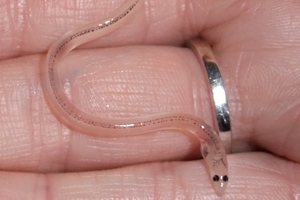Gloucester man ordered to pay almost £11,000 for fishing for eels illegally
A Gloucestershire fisherman who lured valuable elvers into his illegally-placed fishing net instead caught a 5-figure legal bill.

A glass eel in someone's hand
Phillip Croker, of The Oval, Gloucester, was caught fishing for elvers – baby eels – at Oldbury tidal sluice, on the tidal River Severn, on 14 March 2019.
The case was heard at Cheltenham Magistrates’ Court on 28 October 2021, when the 60-year-old was ordered to pay the Environment Agency costs of £10,425.40, a £300 fine and a £30 victim surcharge. Croker’s fishing net was also seized and destroyed.
During the evening of 14 March 2019 Environment Agency Fisheries Enforcement Officers caught Croker fishing illegally for elvers, including fishing with a net in water within 10 metres below the tidal sluice, and using a light to attract elvers into his net.
Elvers migrating from the Sargasso Sea are attracted to freshwater and gather in large numbers below the tidal gate, which controls freshwater entering the saltwater estuary at Oldbury.
When Croker was discovered, officers found around 700 grams of elvers in Croker’s net. At the time of the offence elver prices were approximately £150 per kilogram. The elvers were released back into the Severn.
The fishing of eels on the River Severn is regulated by the Salmon and Freshwater Fisheries Act 1975 as amended by the Marine and Coastal Act 2009 by way of authorisation.
Anglers fishing for eels on the Severn need Environment Agency authorisation and receive a tag that must be attached to their net to show they are fishing legally.
While Croker pleaded guilty to fishing without an Environment Agency tag for his net, he denied setting up his net within 10m below a tidal sluice, fishing unaided by tying his net to the sluice gates and using a light. Magistrates found him guilty on all counts.
Richard Dearnley, Fisheries Enforcement Officer for the Environment Agency, said:
Elver authorisations come with strict conditions aimed at preventing their over-exploitation and to encourage a fair and sustainable fishery.
There has been a huge decline in eel stocks in recent years and their illegal exploitation undermines the Environment Agency and Sustainable Eel Group efforts to conserve and improve eel stocks.
This offence was financially motivated to increase the likelihood of higher catches of elvers due to an unfair advantage.
This case shows we pursue offenders through the courts and will not hesitate to take enforcement action where people flout the rules.
Anyone with information about illegal fishing activities should call the Environment Agency’s 24-hour incident hotline on 0800 807060 or contact Crimestoppers anonymously on 0800 555 111.
Notes to editor
Offences charged:
- Fishing for eels in contravention of condition 8 of the authorisation, in that he did fish with a net in waters within 10 metres below an inlet or outlet of the Oldbury Tidal Sluice.
Contrary to Section 27B(1)(b) of the Salmon and Freshwater Fisheries Act 1975 as amended by the Marine and Coastal Access Act 2009. - Fishing for eels in contravention of condition 5 of the authorisation, in that he did fish with a net which should not be capable of fishing unaided when both hands are removed, in that the net was tied to railings.
Contrary to Section 27B(1)(b) of the Salmon and Freshwater Fisheries Act 1975 as amended by the Marine and Coastal Access Act 2009. - Fishing for eels in contravention of condition 9 of the authorisation, in that he did fish without his authorisation tag attached to his instrument at all times.
Contrary to Section 27B(1)(b) of the Salmon and Freshwater Fisheries Act 1975 as amended by the Marine and Coastal Access Act 2009. - Using a prohibited instrument, namely a light for the purpose of taking or killing eels.
Contrary to Section 1(1)(a)(v) and Schedule 4 of the Salmon and Freshwater Fisheries Act 1975 as amended by the Marine and Coastal Access Act 2009.
About the eel
The European eel, Anguilla Anguilla has a complex life history. It is assumed to spawn in the Sargasso Sea, which is off the Caribbean coast, but this has never been observed. Larvae hatch and drift in the Gulf Stream and the North Atlantic currents towards our shores. By the time they reach the UK shores they are known as glass eels or elvers.
After the young eel has pigmented and been in the freshwater environment for a period of time it becomes what is known as a yellow eel. They remain in this state for the majority of their adult lives in fresh water (up to 35 years). Just before they begin their return journey to the Sargasso Sea their skin colour again changes, this time to a silver colour, which enables them to combat the changes from fresh to saltwater.
Eels have been exploited by man for thousands of years, initially through subsistence fisheries, and now by commercial fisheries supplying a worldwide market. They are used at all stages, from glass eels (elvers) to yellow and silver eel. The fisheries are seasonal, in the case of the elvers in the River Severn they are fished for between 1 February and 25 May.